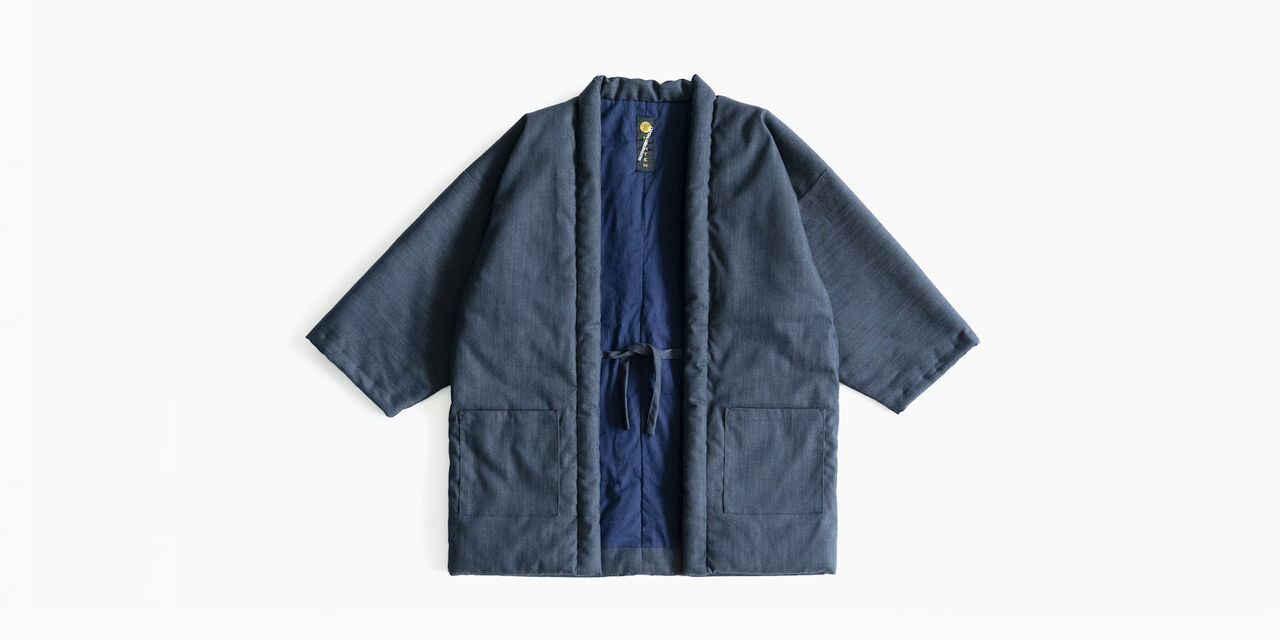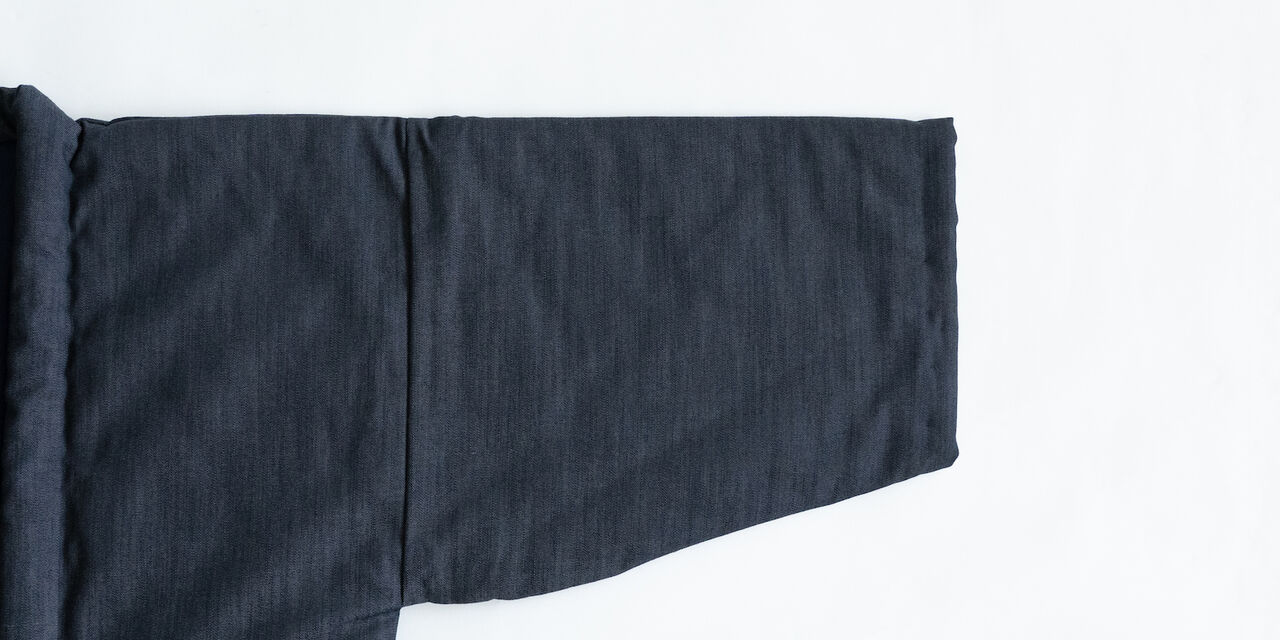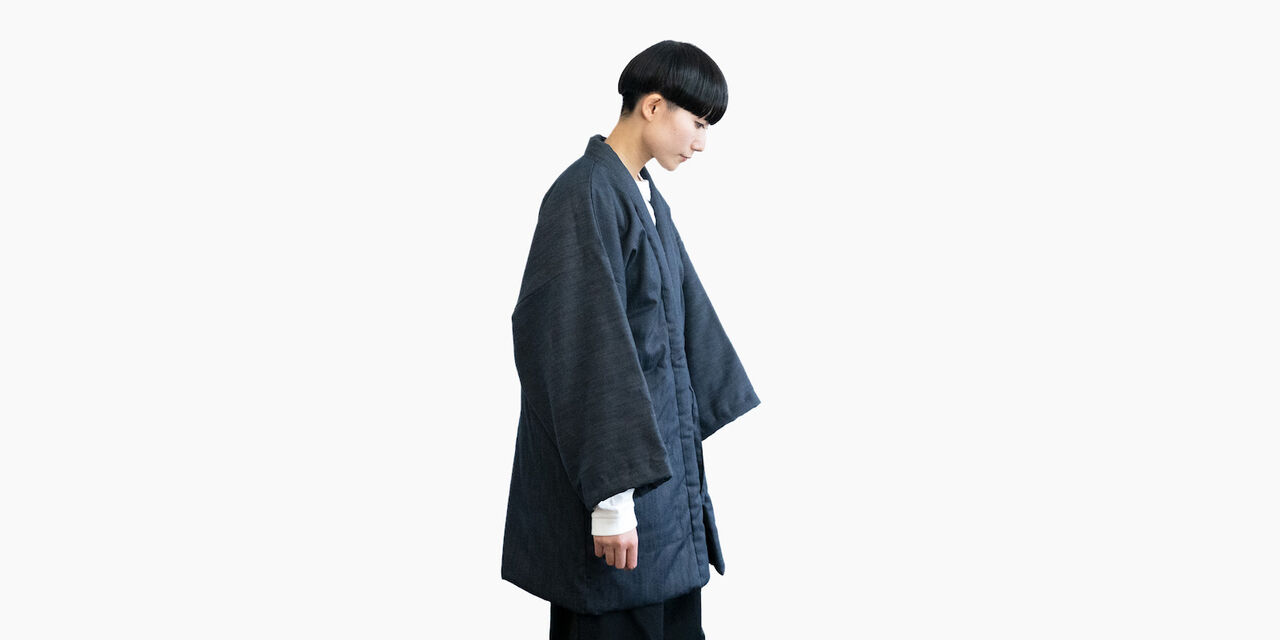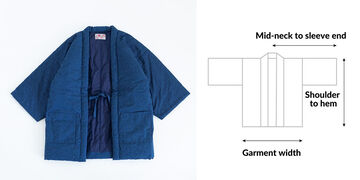온라인 스토어 20만원 이상 구매자 분들께 오리지널 머그컵을 증정합니다!!
D&DEPARTMENT
HANTEN, Japanese style short coat Soft denim
Made in
Japan
신제품
가구
품절 임박
품절
이 제품은 고객님의 시장에서 사용할 수 없습니다.
색상
Red Checked
Soft Denim
2020000102550
2020000102550
HANTEN is a traditional workwear like a warm Japanese style short coat or jacket. It used to be worn over a kimono. The outer fabrics are selected from the precious traditional Japanese fabrics stored in the production area. Each piece is handcrafted by Miyata Orimono craftsmen, who have been making HANTEN in Chikugo City, Fukuoka Prefecture, for more than half a century. Miyata Orimono makes sure that each HANTEN is sewn and finished by hand, as a sewing machine would destroy the volume of the cotton. Besides, they change the width of the needlework according to the strength required for each part of the HANTEN and plump up the area around the collar. All these detailed processes give your HANTEN its special comfort. It is a loose-fitting HANTEN based on its traditional shape. It is soft and fitted, with a string tie in the front and a pocket on each side. Although this product has been manufactured based on the dimensions shown, the actual dimensions of the finished product may vary slightly due to hand sewing.
Cotton Wadding Made From Natural Fibers
This HANTEN is made of 80% natural cotton wadding and 20% polyester wadding. Natural cotton wadding has voids in its fibers that retain heat and resist static electricity. In addition, the polyester wadding is blended in an exquisite ratio that compensates for the puffiness of the cotton wadding without compromising the quality of the cotton wadding. This air-filled wadding allows vapor to escape as you sweat. It keeps you comfortable all day long because natural cotton circulates human body heat.

How to Make a HANTEN?
Working in pairs, they rhythmically stuff the wadding into the HANTEN in an exquisite combination, without speaking aloud. Because the sheets of wadding are piled up and stuffed by hand, the wadding can be carefully placed in every corner, including the back and the hem. With proper care, these HANTEN can be used for a long time and will gradually adapt to your body.

HANTEN FROM "LIFESTOCK"
We have created a new coined term, "LIFESTOCK." It has the opposite meaning of dead stock. Items that remain in stock even though they can still be used as dead stock, or items that are in storage because they are no longer considered valuable because they are no longer in fashion. We collect these items and call them "LIFESTOCK." Our project has been in development since 2014, and aims to utilize their value and connect them to the next stage of manufacturing. We want to take that value and apply it to the next process. HANTEN FROM "LIFESTOCK" was inspired by our own project to reuse fabric samples stored in the respective regions to convey the identity and craftsmanship of each of the 47 prefectures.

HANTEN FROM "LIFESTOCK" 010
Fabric producing region: Banshu (Hyogo Prefecture)
This outer fabric has a raised feel and a soft touch. The textile known as "Banshu-ori" was developed based on techniques introduced from Nishijin in Kyoto more than 200 years ago, and cotton textiles flourished in this area, which was suitable for cotton cultivation. It is characterized by yarn-dyed checks and stripes. It is also known as the famous production area of shirt fabric.

HANTEN FROM "LIFESTOCK" 011
Fabric producing region: Tenryusha (Shizuoka Prefecture)
The outer fabric is a thin denim with a little stretch. The region is known for producing fabrics such as corduroy and velveteen. These fabrics are ideal for hats and winter clothing. The pile yarns are cut and fluffed to produce a soft, thick, lustrous, high quality fabric. However, due to the labor-intensive manufacturing process and changes in the environment, the succession of manufacturing techniques has been threatened in recent years.
Cotton Wadding Made From Natural Fibers
This HANTEN is made of 80% natural cotton wadding and 20% polyester wadding. Natural cotton wadding has voids in its fibers that retain heat and resist static electricity. In addition, the polyester wadding is blended in an exquisite ratio that compensates for the puffiness of the cotton wadding without compromising the quality of the cotton wadding. This air-filled wadding allows vapor to escape as you sweat. It keeps you comfortable all day long because natural cotton circulates human body heat.

How to Make a HANTEN?
Working in pairs, they rhythmically stuff the wadding into the HANTEN in an exquisite combination, without speaking aloud. Because the sheets of wadding are piled up and stuffed by hand, the wadding can be carefully placed in every corner, including the back and the hem. With proper care, these HANTEN can be used for a long time and will gradually adapt to your body.

HANTEN FROM "LIFESTOCK"
We have created a new coined term, "LIFESTOCK." It has the opposite meaning of dead stock. Items that remain in stock even though they can still be used as dead stock, or items that are in storage because they are no longer considered valuable because they are no longer in fashion. We collect these items and call them "LIFESTOCK." Our project has been in development since 2014, and aims to utilize their value and connect them to the next stage of manufacturing. We want to take that value and apply it to the next process. HANTEN FROM "LIFESTOCK" was inspired by our own project to reuse fabric samples stored in the respective regions to convey the identity and craftsmanship of each of the 47 prefectures.

HANTEN FROM "LIFESTOCK" 010
Fabric producing region: Banshu (Hyogo Prefecture)
This outer fabric has a raised feel and a soft touch. The textile known as "Banshu-ori" was developed based on techniques introduced from Nishijin in Kyoto more than 200 years ago, and cotton textiles flourished in this area, which was suitable for cotton cultivation. It is characterized by yarn-dyed checks and stripes. It is also known as the famous production area of shirt fabric.

HANTEN FROM "LIFESTOCK" 011
Fabric producing region: Tenryusha (Shizuoka Prefecture)
The outer fabric is a thin denim with a little stretch. The region is known for producing fabrics such as corduroy and velveteen. These fabrics are ideal for hats and winter clothing. The pile yarns are cut and fluffed to produce a soft, thick, lustrous, high quality fabric. However, due to the labor-intensive manufacturing process and changes in the environment, the succession of manufacturing techniques has been threatened in recent years.
Size: Mid-neck to sleeve end 730mm(28.7inches) Garment width 680mm(26.8inches) Shoulder to hem 820mm (32.3inches)
Material:
Outer fabric: cotton 95%, polyurethane 5%
Lining: cotton 100%
Wadding: cotton 80%, polyester 20%
Material:
Outer fabric: cotton 95%, polyurethane 5%
Lining: cotton 100%
Wadding: cotton 80%, polyester 20%
D&DEPARTMENT PROJECT
Manufactured by: Miyata Orimono
In 1913, Miyata Orimono started weaving the traditional cotton cloth called Kurume-gasuri, which is a textile produced in Kurume City, Fukuoka Prefecture, and surrounding areas. It is mainly used for kimono. Since then, they have been producing the traditional HANTEN for more than half a century.
Miyata Orimono boasted the highest quality and production volume in Japan, shipping 500,000 hanten annually throughout the country at its peak. The selection of yarns for their fabrics, the mix of cotton blends and the high quality of their products are still important to them today.
Manufactured by: Miyata Orimono
In 1913, Miyata Orimono started weaving the traditional cotton cloth called Kurume-gasuri, which is a textile produced in Kurume City, Fukuoka Prefecture, and surrounding areas. It is mainly used for kimono. Since then, they have been producing the traditional HANTEN for more than half a century.
Miyata Orimono boasted the highest quality and production volume in Japan, shipping 500,000 hanten annually throughout the country at its peak. The selection of yarns for their fabrics, the mix of cotton blends and the high quality of their products are still important to them today.
・Sweat and friction may cause color transfer.
・Due to the natural fibers, there may be some shrinkage after washing.
・Please wash gently by hand or in a washing machine on a delicate cycle with a neutral detergent.
・Please wash the item separately to prevent the wadding from shifting.
・Please use a laundry net during washing and spin-drying.
・Do not tumble dry.
・After washing, reshape the item and dry it flat in the shade.
・When ironing, use a cloth to protect the fabric.
・Due to the natural fibers, there may be some shrinkage after washing.
・Please wash gently by hand or in a washing machine on a delicate cycle with a neutral detergent.
・Please wash the item separately to prevent the wadding from shifting.
・Please use a laundry net during washing and spin-drying.
・Do not tumble dry.
・After washing, reshape the item and dry it flat in the shade.
・When ironing, use a cloth to protect the fabric.
HANTEN is a traditional workwear like a warm Japanese style short coat or jacket. It used to be worn over a kimono. The outer fabrics are selected from the precious traditional Japanese fabrics stored in the production area. Each piece is handcrafted by Miyata Orimono craftsmen, who have been making HANTEN in Chikugo City, Fukuoka Prefecture, for more than half a century. Miyata Orimono makes sure that each HANTEN is sewn and finished by hand, as a sewing machine would destroy the volume of the cotton. Besides, they change the width of the needlework according to the strength required for each part of the HANTEN and plump up the area around the collar. All these detailed processes give your HANTEN its special comfort. It is a loose-fitting HANTEN based on its traditional shape. It is soft and fitted, with a string tie in the front and a pocket on each side. Although this product has been manufactured based on the dimensions shown, the actual dimensions of the finished product may vary slightly due to hand sewing.
Cotton Wadding Made From Natural Fibers
This HANTEN is made of 80% natural cotton wadding and 20% polyester wadding. Natural cotton wadding has voids in its fibers that retain heat and resist static electricity. In addition, the polyester wadding is blended in an exquisite ratio that compensates for the puffiness of the cotton wadding without compromising the quality of the cotton wadding. This air-filled wadding allows vapor to escape as you sweat. It keeps you comfortable all day long because natural cotton circulates human body heat.

How to Make a HANTEN?
Working in pairs, they rhythmically stuff the wadding into the HANTEN in an exquisite combination, without speaking aloud. Because the sheets of wadding are piled up and stuffed by hand, the wadding can be carefully placed in every corner, including the back and the hem. With proper care, these HANTEN can be used for a long time and will gradually adapt to your body.

HANTEN FROM "LIFESTOCK"
We have created a new coined term, "LIFESTOCK." It has the opposite meaning of dead stock. Items that remain in stock even though they can still be used as dead stock, or items that are in storage because they are no longer considered valuable because they are no longer in fashion. We collect these items and call them "LIFESTOCK." Our project has been in development since 2014, and aims to utilize their value and connect them to the next stage of manufacturing. We want to take that value and apply it to the next process. HANTEN FROM "LIFESTOCK" was inspired by our own project to reuse fabric samples stored in the respective regions to convey the identity and craftsmanship of each of the 47 prefectures.

HANTEN FROM "LIFESTOCK" 010
Fabric producing region: Banshu (Hyogo Prefecture)
This outer fabric has a raised feel and a soft touch. The textile known as "Banshu-ori" was developed based on techniques introduced from Nishijin in Kyoto more than 200 years ago, and cotton textiles flourished in this area, which was suitable for cotton cultivation. It is characterized by yarn-dyed checks and stripes. It is also known as the famous production area of shirt fabric.

HANTEN FROM "LIFESTOCK" 011
Fabric producing region: Tenryusha (Shizuoka Prefecture)
The outer fabric is a thin denim with a little stretch. The region is known for producing fabrics such as corduroy and velveteen. These fabrics are ideal for hats and winter clothing. The pile yarns are cut and fluffed to produce a soft, thick, lustrous, high quality fabric. However, due to the labor-intensive manufacturing process and changes in the environment, the succession of manufacturing techniques has been threatened in recent years.
Cotton Wadding Made From Natural Fibers
This HANTEN is made of 80% natural cotton wadding and 20% polyester wadding. Natural cotton wadding has voids in its fibers that retain heat and resist static electricity. In addition, the polyester wadding is blended in an exquisite ratio that compensates for the puffiness of the cotton wadding without compromising the quality of the cotton wadding. This air-filled wadding allows vapor to escape as you sweat. It keeps you comfortable all day long because natural cotton circulates human body heat.

How to Make a HANTEN?
Working in pairs, they rhythmically stuff the wadding into the HANTEN in an exquisite combination, without speaking aloud. Because the sheets of wadding are piled up and stuffed by hand, the wadding can be carefully placed in every corner, including the back and the hem. With proper care, these HANTEN can be used for a long time and will gradually adapt to your body.

HANTEN FROM "LIFESTOCK"
We have created a new coined term, "LIFESTOCK." It has the opposite meaning of dead stock. Items that remain in stock even though they can still be used as dead stock, or items that are in storage because they are no longer considered valuable because they are no longer in fashion. We collect these items and call them "LIFESTOCK." Our project has been in development since 2014, and aims to utilize their value and connect them to the next stage of manufacturing. We want to take that value and apply it to the next process. HANTEN FROM "LIFESTOCK" was inspired by our own project to reuse fabric samples stored in the respective regions to convey the identity and craftsmanship of each of the 47 prefectures.

HANTEN FROM "LIFESTOCK" 010
Fabric producing region: Banshu (Hyogo Prefecture)
This outer fabric has a raised feel and a soft touch. The textile known as "Banshu-ori" was developed based on techniques introduced from Nishijin in Kyoto more than 200 years ago, and cotton textiles flourished in this area, which was suitable for cotton cultivation. It is characterized by yarn-dyed checks and stripes. It is also known as the famous production area of shirt fabric.

HANTEN FROM "LIFESTOCK" 011
Fabric producing region: Tenryusha (Shizuoka Prefecture)
The outer fabric is a thin denim with a little stretch. The region is known for producing fabrics such as corduroy and velveteen. These fabrics are ideal for hats and winter clothing. The pile yarns are cut and fluffed to produce a soft, thick, lustrous, high quality fabric. However, due to the labor-intensive manufacturing process and changes in the environment, the succession of manufacturing techniques has been threatened in recent years.
Size: Mid-neck to sleeve end 730mm(28.7inches) Garment width 680mm(26.8inches) Shoulder to hem 820mm (32.3inches)
Material:
Outer fabric: cotton 95%, polyurethane 5%
Lining: cotton 100%
Wadding: cotton 80%, polyester 20%
Material:
Outer fabric: cotton 95%, polyurethane 5%
Lining: cotton 100%
Wadding: cotton 80%, polyester 20%
D&DEPARTMENT PROJECT
Manufactured by: Miyata Orimono
In 1913, Miyata Orimono started weaving the traditional cotton cloth called Kurume-gasuri, which is a textile produced in Kurume City, Fukuoka Prefecture, and surrounding areas. It is mainly used for kimono. Since then, they have been producing the traditional HANTEN for more than half a century.
Miyata Orimono boasted the highest quality and production volume in Japan, shipping 500,000 hanten annually throughout the country at its peak. The selection of yarns for their fabrics, the mix of cotton blends and the high quality of their products are still important to them today.
Manufactured by: Miyata Orimono
In 1913, Miyata Orimono started weaving the traditional cotton cloth called Kurume-gasuri, which is a textile produced in Kurume City, Fukuoka Prefecture, and surrounding areas. It is mainly used for kimono. Since then, they have been producing the traditional HANTEN for more than half a century.
Miyata Orimono boasted the highest quality and production volume in Japan, shipping 500,000 hanten annually throughout the country at its peak. The selection of yarns for their fabrics, the mix of cotton blends and the high quality of their products are still important to them today.
・Sweat and friction may cause color transfer.
・Due to the natural fibers, there may be some shrinkage after washing.
・Please wash gently by hand or in a washing machine on a delicate cycle with a neutral detergent.
・Please wash the item separately to prevent the wadding from shifting.
・Please use a laundry net during washing and spin-drying.
・Do not tumble dry.
・After washing, reshape the item and dry it flat in the shade.
・When ironing, use a cloth to protect the fabric.
・Due to the natural fibers, there may be some shrinkage after washing.
・Please wash gently by hand or in a washing machine on a delicate cycle with a neutral detergent.
・Please wash the item separately to prevent the wadding from shifting.
・Please use a laundry net during washing and spin-drying.
・Do not tumble dry.
・After washing, reshape the item and dry it flat in the shade.
・When ironing, use a cloth to protect the fabric.















